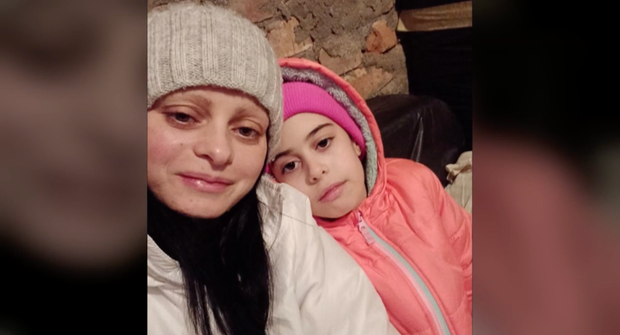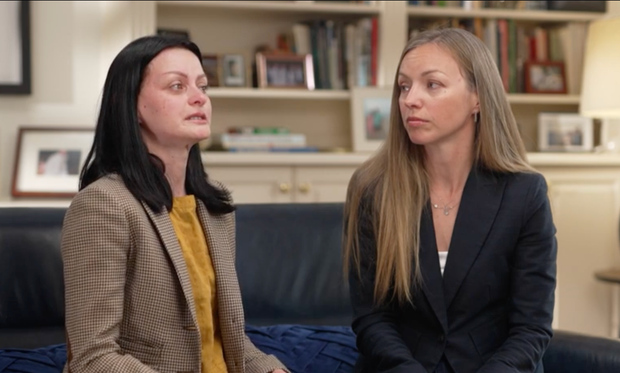Pennington, New Jersey — Yana, a 10-year-old fourth-grader from Ukraine with a bright smile and big dreams, said she has felt welcomed in New Jersey, calling the U.S. “very, very, very nice.”
“I like the flowers here,” Yana said in English, which she has learned remarkably quickly. “People aren’t, like, being mean to anybody. They’re being nice to everybody.”
Asked if she feels safe in America, Yana said, “Yeah.”
Roughly two years ago, Yana and her family had their lives suddenly upended by Russia’s invasion of their native country. Olena Kopchak, Yana’s mother, remembers the very moment their neighborhood in the port city of Mykolaiv was shelled by the Russian military.
“We heard powerful explosions,” Kopchak said in her native tongue. “We could not believe it at the beginning … our house was literally moving. It started to shake. We thought it was the end.”
Russia’s invasion in February 2022 displaced millions of refugees, most of them women and children, triggering the largest refugee exodus in Europe since World War II. As other European countries like Poland and Germany absorbed these refugees, the U.S. quickly followed suit, with President Biden vowing to welcome 100,000 Ukrainians.
In April 2022, the Biden administration created an unprecedented program known as “Uniting for Ukraine,” allowing an unlimited number of Ukrainians sponsored by Americans to come to the U.S. and work here legally without having to go through the lengthy visa process.
“I didn’t sleep on that night when the program was launched. I was sitting at midnight waiting for the website to open,” said Lana Rogers, Kopchak’s sister and an American citizen living in New Jersey.
Rogers used the Uniting for Ukraine program to sponsor her sister and her family, who arrived in New Jersey in June 2022. While they initially lived with Rogers and used government aid for basic necessities, Kopchak and her husband have since found jobs and their own apartment in central New Jersey.
In two years, U.S. immigration officials have approved more than 236,000 cases under the Uniting for Ukraine program, according to the Department of Homeland Security. As of the end of March, more than 187,000 Ukrainians had arrived in the U.S. under the policy.
Another 350,000 Ukrainians have arrived in the U.S. outside of the sponsorship process since the start of the Russian invasion, mainly through temporary visas, according to DHS.
“The Department has delivered on President Biden’s commitment to welcome Ukrainians fleeing Russia’s premeditated and unprovoked war on Ukraine,” Homeland Security Secretary Alejandro Mayorkas said in a statement.
Unlike most U.S. immigration policies, the resettlement of tens of thousands of Ukrainian refugees in American communities has occurred with resounding efficiency and relatively little controversy.
Republican-led states, for example, have filed lawsuits against virtually every major Biden administration immigration policy, including a similar sponsorship program for migrants from Cuba, Haiti, Nicaragua and Venezuela. But the Uniting for Ukraine program has not been challenged in court. In fact, some Republican lawmakers have expressed support for welcoming Ukrainian refugees.
While the arrival of hundreds of thousands of migrants at the U.S.-Mexico border has strained resources in some communities like New York City, Chicago and Denver, the resettlement of Ukrainians has not provoked the same backlash, nor triggered major political problems for the Biden administration.
Unlike the program for Cubans, Haitians, Nicaraguans and Venezuelans, which is capped at 30,000 approvals per month, Uniting for Ukraine has no numerical limit. Applications for the Uniting for Ukraine program are also adjudicated fairly quickly, sometimes in a matter of weeks or even days — a rarity in a backlogged and understaffed U.S. immigration system.
Krish O’Mara Vignarajah, president and CEO of the refugee resettlement organization Global Refuge, said Uniting for Ukraine “shows how the U.S. can act with swiftness when it wants to.”
Vignarajah said geopolitics is partially behind the warm reception in the U.S. for Ukrainian arrivals, who are seen as victims of an anti-American government in Moscow. “There’s certainly a sense of solidarity between the American and Ukrainian people,” she said.
Another reason Ukrainian refugees have enjoyed a smoother transition in the U.S. than some new arrivals, Vignarajah argued, is the unique nature of Uniting for Ukraine.
Those who come to the U.S. under Uniting for Ukraine need an American sponsor willing to help them financially, and they can work legally immediately after setting foot on U.S. soil. Congress also made the first wave of Ukrainian refugees eligible for refugee resettlement benefits, such as food stamps.
Migrants coming from the southern border can’t work legally until 180 days after they request asylum. They’re also generally not eligible for federal benefits. Cubans, Haitians, Nicaraguan and Venezuelans who arrive under the other sponsor policy have to apply for a work permit before they can work legally.
Vignarajah said race may also be playing a role in how Ukrainians have been welcomed, compared to other immigrant populations. “Just as racism and xenophobia have penetrated so many elements of our society, it did factor into the unique treatment that Ukrainians received,” she said.
Still, Ukrainians face their own obstacles. Their permission to be in the U.S. under an immigration authority known as humanitarian parole expires every two years, and they lack a path to permanent legal status or American citizenship.
While the Biden administration has argued that most Ukrainians will eventually go home once the war in their homeland ends, there’s no sign that will happen anytime soon.
“I [cannot] come back,” Kopchak said in English, noting her hometown of Mykolaiv continues to be bombed by the Russians. “I not have no house. I not have nothing.”
Costanza Maio contributed to this report.



